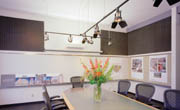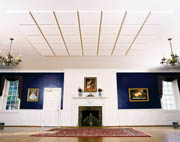

Sure, one can apply acoustical fixes to address the problem after the fact. However, better to anticipate acoustical challenges and address them during the planning phase. Acoustics is just as critical as HVAC systems, lighting, electrical systems and space design.

Absorb and contain
Acoustics is the science of sound. The sound that surrounds us is referred to as the "acoustical environment," which can include a combination of music, conversation, annoying echo or distracting background noise.Acoustics includes a broad range of theories, mathematical equations and other seemingly intimidating information. This shouldn't scare contractors. Keeping two basic acoustic concepts in mind-sound containment and sound absorption-will help one tackle the issue.
Simply put, sound containment refers to keeping distracting noise in a confined space. Sound absorption refers to soaking up excessive noise that is produced within a space. Whether one needs to contain or absorb in any given situation depends on its space and acoustical requirements.
In wide open outdoor spaces, sound generally diminishes as it travels away from its source. Indoor spaces, on the other hand, confine sound waves so they cannot spread out indefinitely and dissipate with distance. As the sound waves bounce around inside the room, they build up because the sound energy is trapped by the room and cannot escape. If the room contains mostly hard, rigid surfaces (metals, stone, wood, plastic) very little sound energy will be absorbed with each bounce or reflection. That means the bouncing and sound effects will continue until the sound eventually fades. So how can wall and ceiling applications contribute to acoustical excellence?
Mass stops sound transmission. A brick wall between a person and a squeaky pump will block noise better than a thin piece of plywood. A brick wall has more mass than plywood, so the brick wall doesn't vibrate much or transmit sound waves to the other side.
Let's say that a wall is made of drywall and a contractor wants to make it more effective at containing noise from an office machine on the one side-side A. A person works on the other side of the wall-side B. The noise from the machine creates secondary noise when it causes the wallboard to vibrate. The vibrations of the wall can vibrate through to the wall onto side B if no barriers exist to prevent it from happening. Barrier product-or mass-woven between staggered stud walls will prevent transmission of sound between the two rooms.
Placing acoustic materials on side B will do nothing to reduce the level of noise transmitted into it. However, those materials will control noise generated within that room and reduce the amount of noise transmitted from that room into another.
The noise level within a room is determined, in large part, by the rate at which sound is absorbed and reverberation, or bouncing, controlled. Ideally, each sound in a room should build up and dissipate consistently. The amount and placement of absorptive materials determines the rate at which sound will dissipate.
Any consideration of the amount of absorptive materials required for a space must begin with a consideration of the intended use of that space. Classrooms, call centers, lecture halls, conference rooms, music practice rooms, recording studios, movie theaters, hotel lobbies, casinos and stadiums all have separate and distinct acoustic needs. In a lecture hall or a conference room, for example, being able to hear individual voices is of paramount importance. No one expects to hear a non-amplified individual voice in a stadium or casino. In those settings, people are lucky to be able to hear the person sitting next
to them.
While stadium-level noise isn't desirable in a classroom, neither is a completely quiet environment in which students can hear the beating of their own hearts-a distraction in itself. Too quiet can also be distracting.

The combination play
Every room or space needs a combination of reflective, or hard, surfaces and absorptive, or soft, materials. An ultra-modern room that has a hardwood floor, no area rugs, a metal ceiling, painted walls, wood furniture, glass and marble tables and multiple unadorned windows will be loud. Few of these materials absorb sound. The same space decorated with overstuffed furniture, decorative throws and pillows, heavy fabric window coverings, plush carpeting, wallpaper and a fabric ceiling application will have a very different noise level. Neither is right or wrong-it depends on how the occupant intends to use the space.Parallels can be drawn with business settings. Heavy drapes and overstuffed furniture may not be appropriate. But acoustical products (ceiling tiles, wall panels and baffles) serve the same purpose. They absorb sound and control reverberation created from sound bouncing off hard surfaces.
The amount of absorption necessary in a space is dependent on its intended use, the size and shape of the room, the ceiling height and materials already in the room.
What is best, containment, absorption or a combination of the two? Separate types of products for each or products that do both? How's an acoustics rookie supposed to figure out the best game plan?
The good news is that one doesn't have to. Yes, there are separate types of products for each purpose. Yes, there are some products, including ceiling tiles that absorb and contain sound. Manufacturers provide assistance and product-specific guidelines. They or acoustic consultants can help determine the type and precise amount of acoustic material needed for any space or application.
Let's look at the simple example of a room with a very noisy machine. One can see that one size doesn't fit all. One has several choices, presented in order of greatest impact on noise control:
Build an enclosure: Line most of the inside of a plywood or sheet metal rigid enclosure with acoustical panels. If the enclosure requires a vent, create one that provides a turn for the air before it escapes. Line the vent with acoustical panel material. (Provides containment and absorption.)
Build a barrier or shield: Block the area between people and the noise source with a rigid barrier. Mount acoustical barrier material or glue acoustic panels to plywood on the noisy side near the source of noise. (Provides some containment and absorption.)
Treat the room: Apply acoustical panels to the ceiling and walls or hang acoustical baffles from the ceiling for a noticeable reduction in noise. (Provides absorption.)
Treat the wall behind the noise source: Treat the wall behind the noise source with acoustical panels. Cover a space twice the square footage of the shadow the machine creates on the wall. (Provides some absorption.)
Baseline awareness
In terms of sound absorption performance, acoustical products run the gamut from exceptional to useless. Manufacturers of acoustical materials use noise reduction coefficients, or NRCs, to compare and rate performance. A material's NRC represents the average of its sound absorption coefficients-the measure of efficiency in absorbing acoustical energy-at a range of frequencies. A sound absorption coefficient of 0.55 means the material absorbs 55 percent of sound and reflects the remaining 45 percent. If a product's specifications do not include an NRC, it probably is embarrassingly low and the manufacturer chose not to share it.
Manufacturers use sound transmission class to classify acoustical barrier materials. A product's STC indicates how much noise it blocks. The higher the STC, the more noise it stops. A barrier with STC 25 will allow normal conversation to be heard. An STC of 50 will prevent a person on one side of a partition from being able to hear shouting on the other side.
NRC and STC aside, occupants of any building or home deserve and appreciate freedom from the negative effects-disturbed sleep and activities, lowered work productivity, impaired hearing-of unwanted or unexpected noise.
The bottom line is that wall and ceiling contractors don't have to be the experts. They just need to have a baseline awareness of major acoustical issues and enough foresight to know that addressing them from the get-go or raising the issue prior to a remodel will result in happier customers all around. Then call in the experts for assistance if getting into the nitty-gritty of acoustics isn't your thing.

Report Abusive Comment